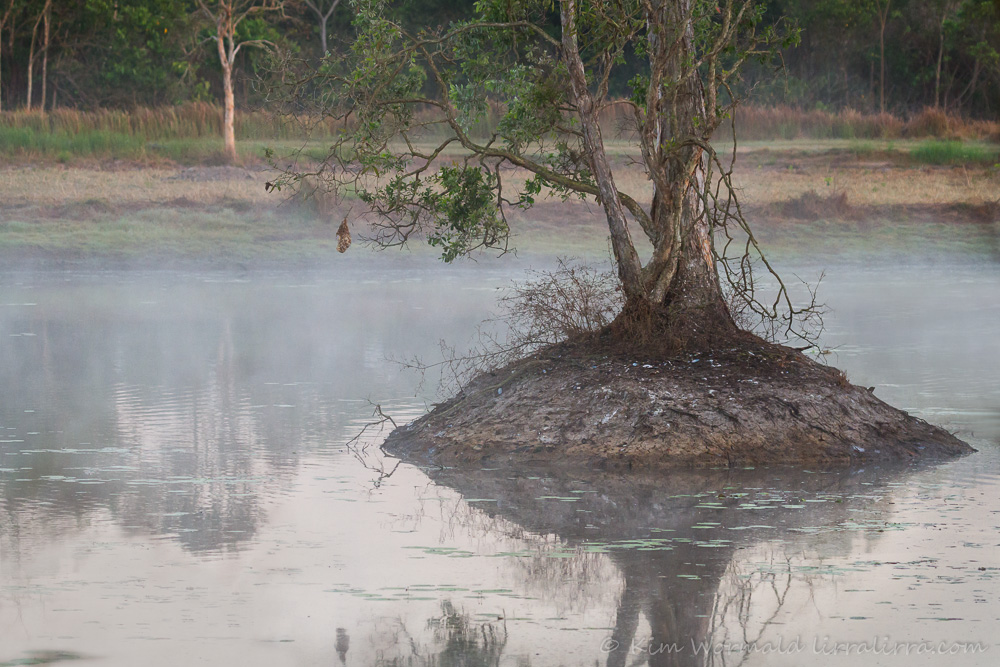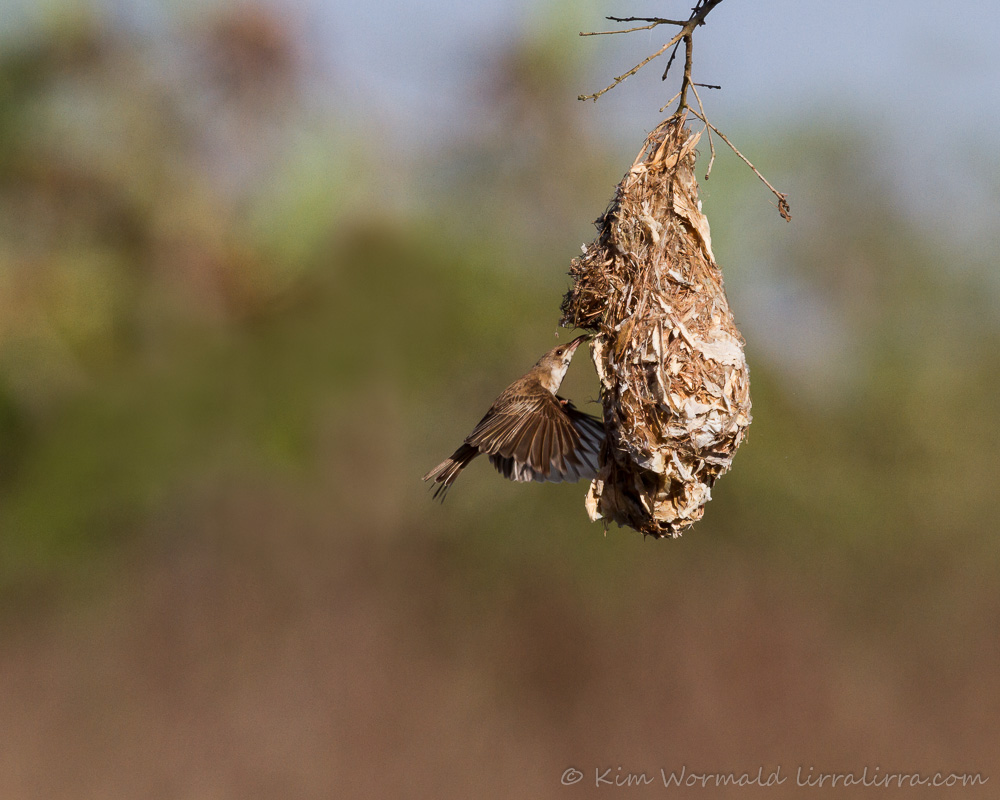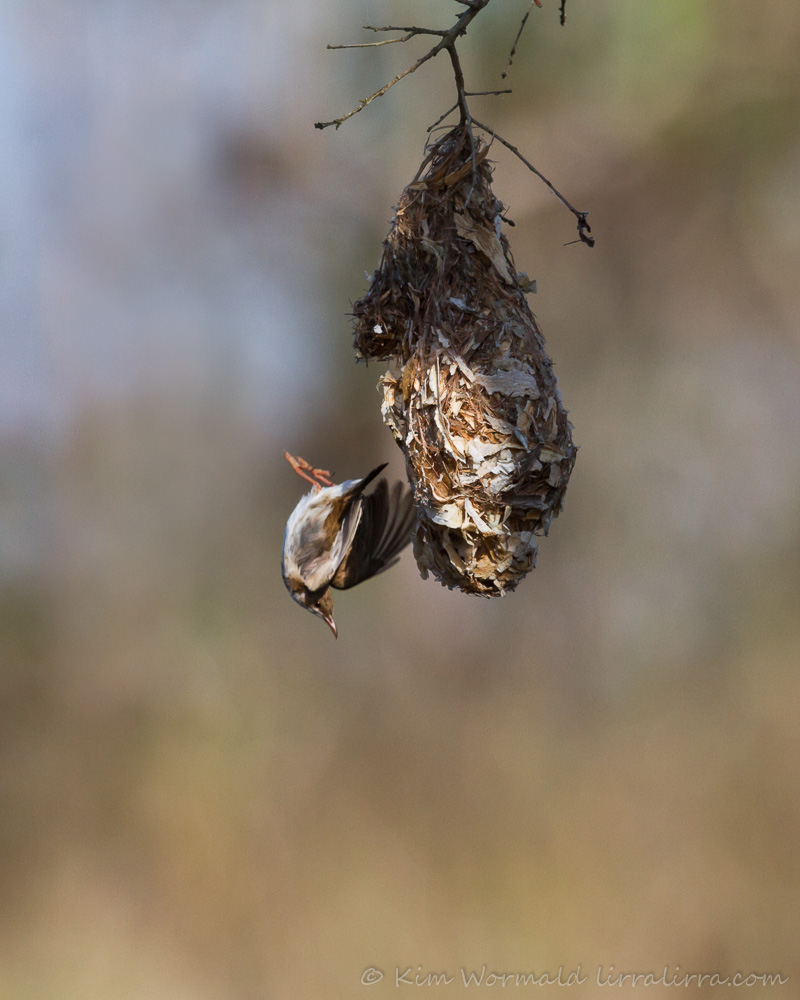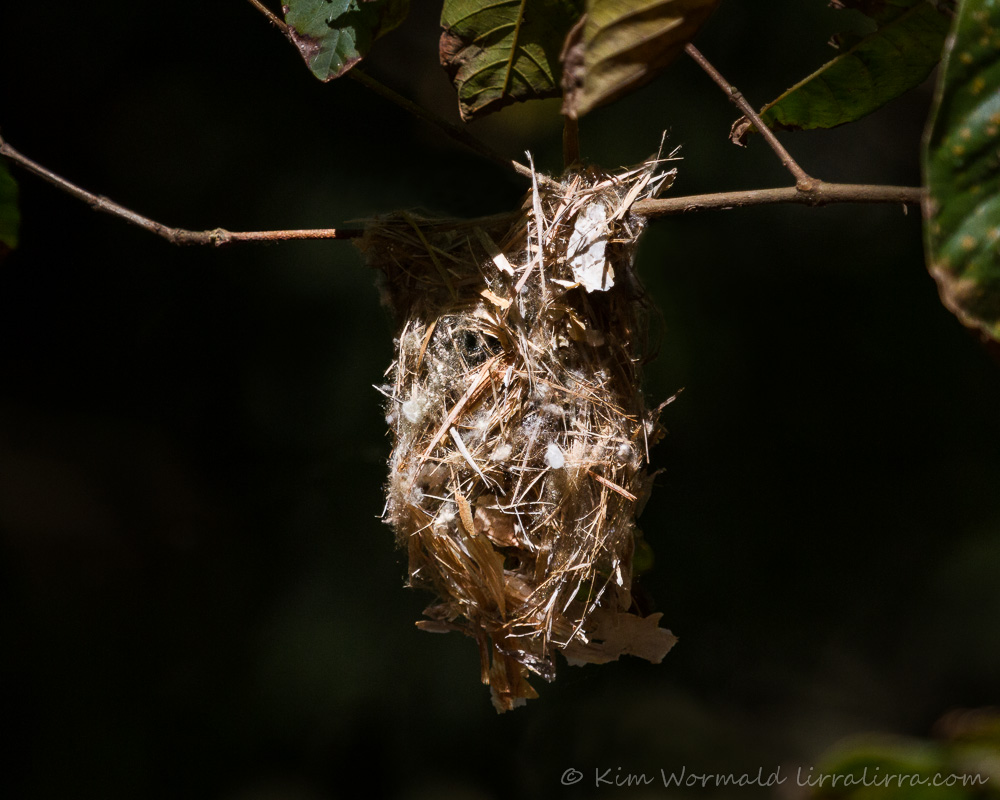Imagine signs warning ‘Beware of Crocodiles’, imagine a small splash on the far bank that startles nearby water birds into flight, imagine the Jaws theme getting louder in your head as a huge ripple moves steadily towards you.
At that point I decided it was pretty stupid to stay sitting at the water’s edge regardless of the hope that Brown-backed Honeyeaters were about to return to their nest. After living in Darwin I’m aware of the reality and frequency of croc attacks and I reluctantly scarpered up the bank with my camera gear.
 Tyto Wetlands, Ingham, Queensland – early on a misty morning
Tyto Wetlands, Ingham, Queensland – early on a misty morning
Canon 7D, 100-400mm L IS USM, 1/250, f/5.6, 2/3 exposure compensation, ISO 1600, focal length 135mm
The image above was taken just before sunrise from higher up the bank than where I had been sitting. Even with the aperture wide open I still needed the highest ISO I use and 2/3 exposure compensation. The nest is easy to see from this angle but surprisingly difficult from other spots.
I ventured down again a few times over the next couple of days but it was hard to relax at the water’s edge while parents safely on a bridge were yelling crocodile warnings to children they could practically touch. I tried to convince myself that the splash and ripple I’d witnessed was a large fish but locals spoke about recent floods and said a crocodile was a possibility.
I managed to get shots of honeyeaters at the nest, and many more of the nest without any honeyeaters – their visits were crazily fast. On our final morning in Ingham Glenn kindly succumbed to pressure and agreed to be on croc watch, which I know is a ridiculous waste of time but which might have been more useful if he’d been less than ten metres away and hadn’t been reading a book. Nonetheless it was comforting to have him there, at least someone would have heard my last words, maybe something like, “What ISO should I use for this!”
 Brown-backed Honeyeater
Brown-backed Honeyeater
Canon 7D, 100-400mm L IS USM, 1/2000, f/6.3, ISO 400, focal length 356mm
I don’t think chicks had hatched when I first saw the nest as the parent birds visited rarely, possibly to swap roles, and there were no signs of carried food. By my final visit the parents visited more frequently and carried insects and grubs for the nestlings. In the image above a small green caterpillar was on the menu; I wonder if it was destined for Brown-backed Honeyeater chicks or for the chick of the parasitic Brush Cuckoo I heard calling. The image above shows the diagnostic pinkish-brown bill and legs of the 12cm long honeyeater.
 Brown-backed Honeyeater
Brown-backed Honeyeater
Canon 7D, 100-400mm L IS USM, 1/2000, f/6.3, ISO 400, focal length 365mm
I like the protective ‘porch’ the honeyeaters have constructed over the entrance to the nest. Brown-backed Honeyeaters are endemic to the far north-west Queensland coast and I very much enjoyed watching them.
 Brown-backed Honeyeater
Brown-backed Honeyeater
Canon 7D, 100-400mm L IS USM, 1/1600, f/6.3, ISO 400, focal length 400mm
Every time the honeyeaters visited the nest they did so in different ways. They arrived from various directions and entered the nest swiftly, sometimes leaving a little of their tail peeking through the entrance. They left the nest differently each time too, varying the amount of time spent in the nest and the direction they headed when exiting. What a brilliant way to foil predators … and photographers actually. The image above captured an amazing back-flip exit as the honeyeater looped the loop, I was pleased to see that its eye is visible and even has a little catch-light.
I found this under-construction Brown-backed Honeyeater nest at the edge of a sugarcane plantation. Apparently their nests generally overhang water but this one was overhanging a track. As I watched, the adult birds carefully placed a range of building materials including paperbark strips of various sizes, cobwebs and spider egg-sacs. What brilliant engineers! They used webs to hold the paperbark together in a criss-cross patterns and several egg-sacs can be seen in the image. I can imagine the spiderlings hatching and providing a source of nourishment for the nestlings.
We were in Ingham for the BirdLife Australia Digital Photography in the Bush event. Tom Oliver was greatly missed (Silvereye Triptych) but it was good to catch up with lovely friends, to meet new friends and to add over 50 new species to the lirralirra Bird Call.
Happy birding to you all, Kim
NB It is possible to receive a weekly email letting you know that lirralirra has been updated – just add your address to the ‘Subscribe to email’ box above right.
Also, I recently added a Facebook ‘like’ button. Thank you ‘likers’ – I like you too!


Fascinating sequence. The misty morning shot of the nest looks like a painting. Excellent captures of the Honeyeaters.
Thanks Dave! It does look like a painting, I hadn’t realised that before, the colours were lovely. I have early morning shots of the big lake with beautiful colours too, maybe I’ll post them one day.
haaa, i m haapy you just open the comments…
you just open the comments…
last time i was thinking your blog becomes a private club and no way to say something loool
thanks for the scene and the explanations, the pictures in fligtht are deligthful, and the nest is an amazing construction for this little bird, it must takes several weeks to build it
have a nice sunday, and happy birding kim =))
Oh YAY, comments are working! ‘A private club’ hahaha, you’re funny! I’m glad you enjoyed the post, you’ve got me wondering how long it takes the honeyeaters to build the nest. From the rate they were working on the nest shown at the end of the post I don’t think it would be more than a week, I’ll try to find out. Have a lovely weekend Eric and thanks for commenting
Apologies! Comments were initially closed on this post which is a shame as I love hearing your thoughts. They are up and running again now